Evaluation of Noise Levels in a University Dental Clinic
Abstract
1. Introduction
2. Background
3. Materials and Methods
3.1. Mapping of Settings for Sound Measurements
3.2. Sample of the Study
3.3. Measurement Methodology
3.4. Equipment and Validation for Measurements
4. Results
Description of Results
5. Discussion
5.1. Considerations for Dental-Clinic Occupants
5.2. Recommendation for Dental-Clinic Administration
5.3. Limitations of the Study
6. Conclusions
Author Contributions
Funding
Institutional Review Board Statement
Informed Consent Statement
Data Availability Statement
Acknowledgments
Conflicts of Interest
Abbreviations
References
- Basner, M.; Babisch, W.; Davis, A.; Brink, M.; Clark, C.; Janssen, S.; Stansfeld, S. Auditory and non-auditory effects of noise on health. Lancet 2014, 12, 1325–1332. [Google Scholar] [CrossRef]
- Themann, C.L.; Masterson, E.A. Occupational noise exposure: A review of its effects, epidemiology, and impact with recommendations for reducing its burden. J. Acoust. Soc. Am. 2019, 146, 3879. [Google Scholar] [CrossRef]
- Neitzel, R.L.; Svensson, E.B.; Sayler, S.K.; Ann-Christin, J. A comparison of occupational and nonoccupational noise exposures in Sweden. Noise Health 2014, 16, 270–278. [Google Scholar] [CrossRef]
- Lee, Y.; Lee, S.; Lee, W. Occupational and Environmental Noise Exposure and Extra-Auditory Effects on Humans: A Systematic Literature Review. GeoHealth 2023, 7, e2023GH000805. [Google Scholar] [CrossRef]
- Antoniadou, M.; Tziovara, P.; Antoniadou, C. The Effect of Sound in the Dental Office: Practices and Recommendations for Quality Assurance—A Narrative Review. Dent. J. 2022, 10, 228. [Google Scholar] [CrossRef]
- Wells, T.S.; Seelig, A.D.; Ryan, M.A.; Jones, J.M.; Hooper, T.I.; Jacobson, I.G.; Boyko, E.J. Hearing loss associated with US military combat deployment. Noise Health 2015, 17, 34–42. [Google Scholar] [CrossRef]
- Alberti, G.; Portelli, D.; Galletti, C. Healthcare Professionals and Noise-Generating Tools: Challenging Assumptions about Hearing Loss Risk. Int. J. Environ. Res. Public Health 2023, 20, 6520. [Google Scholar] [CrossRef]
- Dierickx, M.; Verschraegen, S.; Wierinck, E.; Willems, G.; van Wieringen, A. Noise Disturbance and Potential Hearing Loss Due to Exposure of Dental Equipment in Flemish Dentists. Int. J. Environ. Res. Public Health 2021, 18, 5617. [Google Scholar] [CrossRef]
- Chadha, S.; Kamenov, K.; Cieza, A. The world report on hearing, 2021. Bull. World Health Organ. 2021, 199, 242–242A. [Google Scholar] [CrossRef]
- Fuente, A.; Hickson, L. Noise-induced hearing loss in Asia. Int. J. Audiol. 2011, 50, S3–S10. [Google Scholar] [CrossRef]
- Vos, T.; Flaxman, A.D.; Naghavi, M. Years lived with disability (YLDs) for 1160 sequelae of 289 diseases and injuries 1990–2010: A systematic analysis for the Global Burden of Disease Study 2010. Lancet 2012, 380, 2163–2196. [Google Scholar] [CrossRef]
- Health Assured Team. Noise Levels at Work & Mental Health. 9 December 2019. Available online: https://www.healthassured.org/blog/noise-at-work-mental-health/ (accessed on 20 August 2023).
- Oishi, N.; Schacht, J. Emerging treatments for noise-induced hearing loss. Expert Opin. Emerg. Drugs 2011, 16, 235–245. [Google Scholar] [CrossRef]
- Karpa, M.J.; Gopinath, B.; Beath, K. Associations between hearing impairment and mortality risk in older persons: The Blue Mountains Hearing Study. Ann. Epidemiol. 2010, 20, 452–459. [Google Scholar] [CrossRef]
- Fritschi, L.; Brown, A.L.; Kim, R.; Schwela, D.H.; Kephalopoulos, S. (Eds.) Burden of Disease from Environmental Noise; World Health Organization: Bonn, Germany, 2011.
- Kurabi, A.; Keithley, E.M.; Housley, G.D.; Ryan, A.F.; Wong, A.C. Cellular mechanisms of noise-induced hearing loss. Hear. Res. 2017, 349, 129–137. [Google Scholar] [CrossRef]
- Natarajan, N.; Batts, S.; Stankovic, K.M. Noise-Induced Hearing Loss. J. Clin. Med. 2023, 12, 2347. [Google Scholar] [CrossRef]
- Miedema, H.M.; Oudshoorn, C.G. Annoyance from transportation noise: Relationships with exposure metrics DNL and DENL and their confidence intervals. Environ. Health Perspect. 2001, 109, 409–416. [Google Scholar] [CrossRef]
- Themann, C.L.; Suter, A.H.; Stephenson, M.R. National research agenda for the prevention of occupational hearing loss—Part 1. Sem. Hear. 2013, 34, 145–207. [Google Scholar] [CrossRef]
- Muzet, A. Environmental noise, sleep and health. Sleep. Med. Rev. 2007, 11, 135–142. [Google Scholar] [CrossRef]
- Peng, L.; Chen, J.; Jiang, H. The impact of operating room noise levels on stress and work efficiency of the operating room team: A protocol for systematic review and meta-analysis. Medicine 2022, 101, e28572. [Google Scholar] [CrossRef]
- van Kempen, E.; Babisch, W. The quantitative relationship between road traffic noise and hypertension: A meta-analysis. J. Hypertens. 2012, 30, 1075–1086. [Google Scholar] [CrossRef]
- Sørensen, M.; Andersen, Z.J.; Nordsborg, R.B. Road traffic noise and incident myocardial infarction: A prospective cohort study. PLoS ONE 2012, 7, e39283. [Google Scholar] [CrossRef] [PubMed]
- Kerns, E.; Masterson, E.A.; Themann, C.L.; Geoffrey, T.; Calvert, M. Cardiovascular conditions, hearing difficulty, and occupational noise exposure within US industries and occupations. Am. J. Ind. Med. 2018, 61, 477–491. [Google Scholar] [CrossRef] [PubMed]
- Stansfeld, S.A.; Matheson, M.P. Noise pollution: Non-auditory effects on health. Br. Med. Bull. 2003, 68, 243–257. [Google Scholar] [CrossRef]
- Friedrich, M.G.; Boos, M.; Pagel, M. New technical solution to minimise noise exposure for surgical staff: The ‘silent operating theatre optimisation system’. BMJ Innov. 2017, 3, 196–205. [Google Scholar] [CrossRef]
- Qsaibati, M.L.; Ibrahim, O. Noise levels of dental equipment used in dental college of Damascus University. Dent. Res. J. 2014, 11, 624–630. [Google Scholar]
- Ohrstrom, E.; Skanberg, A.; Svensson, H.; Gidlof-Gunnarsson, A. Effects of road traffic noise and the benefit of access to quietness. J. Sound Vibrat. 2006, 295, 40–59. [Google Scholar] [CrossRef]
- Antoniadou, M. Estimation of Factors Affecting Burnout in Greek Dentists before and during the COVID-19 Pandemic. Dent. J. 2022, 10, 108. [Google Scholar] [CrossRef] [PubMed]
- Busch-Vishniac, I.J.; West, J.E.; Barnhill, C.; Hunter, T.; Orellana, D.; Chivukula, R. Noise levels in Johns Hopkins Hospital. J. Acoust. Soc. Am. 2005, 118, 3629–3645. [Google Scholar] [CrossRef]
- Berglund, B.; Lindvall, T.; Schwela, D.H. Guidelines for Community Noise; World Health Organization (WHO): Geneva, Switzerland, 1999. Available online: http://whqlibdoc.who.int/hq/1999/a68672.pdf (accessed on 11 July 2013).
- Messingher, G.; Ryherd, E.E.; Ackerman, J. Hospital noise and staff performance. J. Acoust. Soc. Am. 2012, 132, 2031. [Google Scholar] [CrossRef]
- Antoniadou, M. Quality of Life and Satisfaction from Career and Work-Life Integration of Greek Dentists before and during the COVID-19 Pandemic. Int. J. Environ. Res. Public Health 2022, 19, 9865. [Google Scholar] [CrossRef]
- Ryherd, E.E.; Waye, K.P.; Ljungkvist, L. Characterizing noise and perceived work environment in a neurological intensive care unit. J. Acoust. Soc. Am. 2008, 123, 747–756. [Google Scholar] [CrossRef] [PubMed]
- Eichwald, J.; Carroll, Y. Loud Noise: Too Loud, Too Long! J. Environ. Health 2018, 80, 34–35. [Google Scholar] [PubMed]
- Choosong, T.; Kaimook, W.; Tantisarasart, R.; Sooksamear, P.; Chayaphum, S.; Kongkamol, C.; Srisintorn, W.; Phakthongsuk, P. Noise exposure assessment in a dental school. Saf. Health Work. 2011, 2, 348–354. [Google Scholar] [CrossRef]
- da Cunha, K.; dos Santos, R.; Klien, C. Assessment of noise intensity in a dental teaching clinic. BDJ Open 2017, 3, 17010. [Google Scholar] [CrossRef]
- Kadanakuppe, S.; Bhat, P.K.; Jyothi, C.; Ramegowda, C. Assessment of noise levels of the equipments used in the dental teaching institution, Bangalore. Indian J. Dent. Res. 2011, 22, 424–431. [Google Scholar] [CrossRef] [PubMed]
- Dutta, A.; Mala, K.; Acharya, S.R. Sound levels in conservative dentistry and endodontics clinic. J. Conserv. Dent. 2013, 16, 121–125. [Google Scholar] [CrossRef]
- Burk, A.; Neitzel, R.L. An exploratory study of noise exposures in educational and private dental clinics. J. Occup. Environ. Hyg. 2016, 13, 741–749. [Google Scholar] [CrossRef][Green Version]
- Ai, Z.; Mak, C.; Wong, H. Noise level and its influences on dental professionals in a dental hospital in Hong Kong. Build. Serv. Eng. Res. Technol. 2017, 38, 522–535. [Google Scholar] [CrossRef]
- Amine, M.; Aljalil, Z.; Redwane, A.; Delfag, I.; Lahby, I.; Bennani, A. Assessment of Noise Levels of Equipment Used in the Practical Dental Teaching Activities. Int. J. Dent. 2021, 2021, 6642560. [Google Scholar] [CrossRef]
- Paramashivaiah, R.; Prabhuji, M.L. Mechanized scaling with ultrasonics: Perils and proactive measures. J. Indian Soc. Periodontol. 2013, 17, 423–428. [Google Scholar] [CrossRef]
- Mohan, K.M.; Chopra, A.; Guddattu, V.; Singh, S.; Upasana, K. Should Dentists Mandatorily Wear Ear Protection Device to Prevent Occupational Noise-induced Hearing Loss? A Randomized Case-Control Study. J. Int. Soc. Prev. Community Dent. 2022, 12, 513–523. [Google Scholar] [CrossRef] [PubMed]
- Verbeek, J.H.; Kateman, E.; Morata, T.C.; Dreschler, W.A.; Mischke, C. Interventions to prevent occupational noise-induced hearing loss. Cochrane Database Syst. Rev. 2012, 10, CD006396. [Google Scholar] [PubMed]
- Murphy, W.; Franks, J. NIOSH Criteria for a Recommended Standard: Occupational Noise Exposure, Revised Criteria 1998. J. Acoust. Soc. Am. 2002, 111, 2397. [Google Scholar] [CrossRef]
- Johnson, T.A.; Cooper, S.; Stamper, G.C.; Chertoff, M. Noise Exposure Questionnaire: A Tool for Quantifying Annual Noise Exposure. J. Am. Acad. Audiol. 2017, 28, 14–35. [Google Scholar] [CrossRef]
- Directive 2003/10/EC of the European Parliament and of the Council on the Minimum Health and Safety Requirements Regarding the Expo. 6 February 2003. Available online: https://eur-lex.europa.eu/LexUriServ/LexUriServ.do?uri=OJ:L:2003:042:0038:0044:EN:PDF (accessed on 20 August 2023).
- E-Nomothesia.gr. Greek Presidential Degree No 149/2006. Available online: https://www.e-nomothesia.gr/kat-ergasia-koinonike-asphalise/pd-149-2006.html (accessed on 20 August 2023).
- Occupational Safety Health Administration, O.S.H.A. Available online: https://www.osha.gov/ (accessed on 20 August 2023).
- The National Institute for Occupational Safety and Health (NIOSH). Available online: https://www.cdc.gov/niosh/index.htm (accessed on 20 August 2023).
- US Environmental Protection Agency (EPA). Available online: https://www.epa.gov/ (accessed on 20 August 2023).
- Hammer, A.; Coene, M.; Rooryck, J.; Govaerts, P. The production of Dutch finite verb morphology: A comparison between hearing-impaired CI children and specific language impaired children. Lingua 2014, 139, 68–79. [Google Scholar] [CrossRef]
- Neitzel, R. Contributions of non-occupational activities to total noise exposure of construction workers. Ann. Occup. Hyg. 2004, 48, 463–473. [Google Scholar] [CrossRef]
- Carter, L.; Williams, W.; Black, D.; Bundy, A. The leisure-noise dilemma: Hearing loss or hearsay? What does the literature tell us? Ear Hear. 2014, 35, 491–505. [Google Scholar] [CrossRef]
- Antoniadou, M.; Intzes, A.; Kladouchas, C.; Christou, I.; Chatzigeorgiou, S.; Plexida, M.; Stefanidakis, V.; Tzoutzas, I. Factors Affecting Water Quality and Sustainability in Dental Practices in Greece. Sustainability 2023, 15, 9115. [Google Scholar] [CrossRef]
- Baseer, M.; Al Saffan, A.; Al Masoud, S.; Dahy, W.T.; Aldali, H.W.; Walid, B.A.; Walid, B.R.; Al Mugeiren, O.M. Noise levels encountered in university dental clinics during different specialty treatments. J. Fam. Med. Prim. Care 2021, 10, 2987–2992. [Google Scholar] [CrossRef]
- Bhagwat, S.; Hirlekar, P.; Padhye, L. Sound levels in conservative dentistry and endodontics clinic. Indian J. Oral Health Res. 2019, 5, 11–16. [Google Scholar] [CrossRef]
- Mojarad, F.; Massum, T.; Samavat, H. Noise Levels in Dental Offices and Laboratories in Hamedan, Iran. J. Dent. 2009, 6, 181–186. [Google Scholar]
- Leather, P.; Beale, D.; Sullivan, L. Noise, psychosocial stress and their interaction in the workplace. J. Environ. Psychol. 2003, 23, 213–222. [Google Scholar] [CrossRef]
- Altinöz, H.C.; Gökbudak, R.; Bayraktar, A.; Belli, S. A pilot study of measurement of the frequency of sounds emitted by high-speed dental air turbines. J. Oral Sci. 2001, 43, 189–192. [Google Scholar] [CrossRef] [PubMed]
- Forman-Franco, B.; Abramson, A.L.; Stein, T. High-speed drill noise and hearing: Audiometric survey of 70 dentists. J. Am. Dent. Assoc. 1978, 97, 479–482. [Google Scholar] [CrossRef]
- Sockwell, C.L. Dental handpieces and rotary cutting instruments. Dent. Clin. N. Am. 1971, 15, 219–244. [Google Scholar] [CrossRef]
- Kessler, H.E. Use of earplugs. J. Am. Dent. Assoc. 1960, 61, 715. [Google Scholar] [CrossRef]
- Killion, M.; Devilbliss, E.D.; Stewart, J. An earplug with uniform 15 dB attenuation. Hear. J. 1988, 41, 14–17. [Google Scholar]
- Musicians Earplugs. 2012. Available online: http://www.etymotic.com/pdf/erme-brochure.pdf (accessed on 20 August 2023).
- Clean and Quiet Air. 2009. Available online: http://www.jun-air.com/catalogs/dental_english.pdf (accessed on 20 August 2023).
- International Labour Organization, NATLEX. Database of National Labour, Social Security and Related Human Rights Legislation. Available online: https://www.ilo.org/dyn/natlex/natlex4.detail?p_lang=en&p_isn=81113Section226219 (accessed on 20 August 2023).
- Section 226219.74 Dental Vacuum and Evacuation Equipment. 2010. Available online: http://www.wbdg.org/ccb/VA/VAASC/VA%2022%2062%2019.74.pdf (accessed on 20 August 2023).
- European Commission. Position Paper on Dose Response Relationships between Transportation Noise and Annoyance; European Communities: Luxembourg, 2002. [Google Scholar]
- Birk, M.; Ivina, O.; von Klot, S.; Babisch, W.; Heinrich, J. Road traffic noise: Self-reported noise annoyance versus gis modelled road traffic noise exposure. J. Environ. Monit. 2011, 13, 3237–3245. [Google Scholar] [CrossRef]
- Sundstrom, E.; Town, J.P.; Rice, R.W.; Osborn, D.P.; Brill, M. Office Noise, Satisfaction, and Performance. Environ. Behav. 1994, 26, 195–222. [Google Scholar] [CrossRef]
- NIOSH. Available online: https://www.cdc.gov/niosh/docs/98-126/pdfs/CriteriaDoc_98-126.pdf?id=10.26616/NIOSHPUB98126 (accessed on 20 August 2023).
- ISO 1999:1990. Acoustics — Determination of Occupational Noise Exposure and Estimation of Noise-Induced Hearing Impairment. Available online: https://www.iso.org/standard/6759.html (accessed on 20 August 2023).
- ISO 1999:2013. Acoustics — Estimation of Noise-Induced Hearing Loss. Available online: https://www.iso.org/standard/45103.html (accessed on 20 August 2023).
- SVANTEK ACADEMY. Available online: https://svantek.com/academy/sound-pressure-level-spl/#:~:text=Sound%20pressure%20level%20(SPL)%20can,than%20120%20dB%20is%20intolerable (accessed on 20 August 2023).

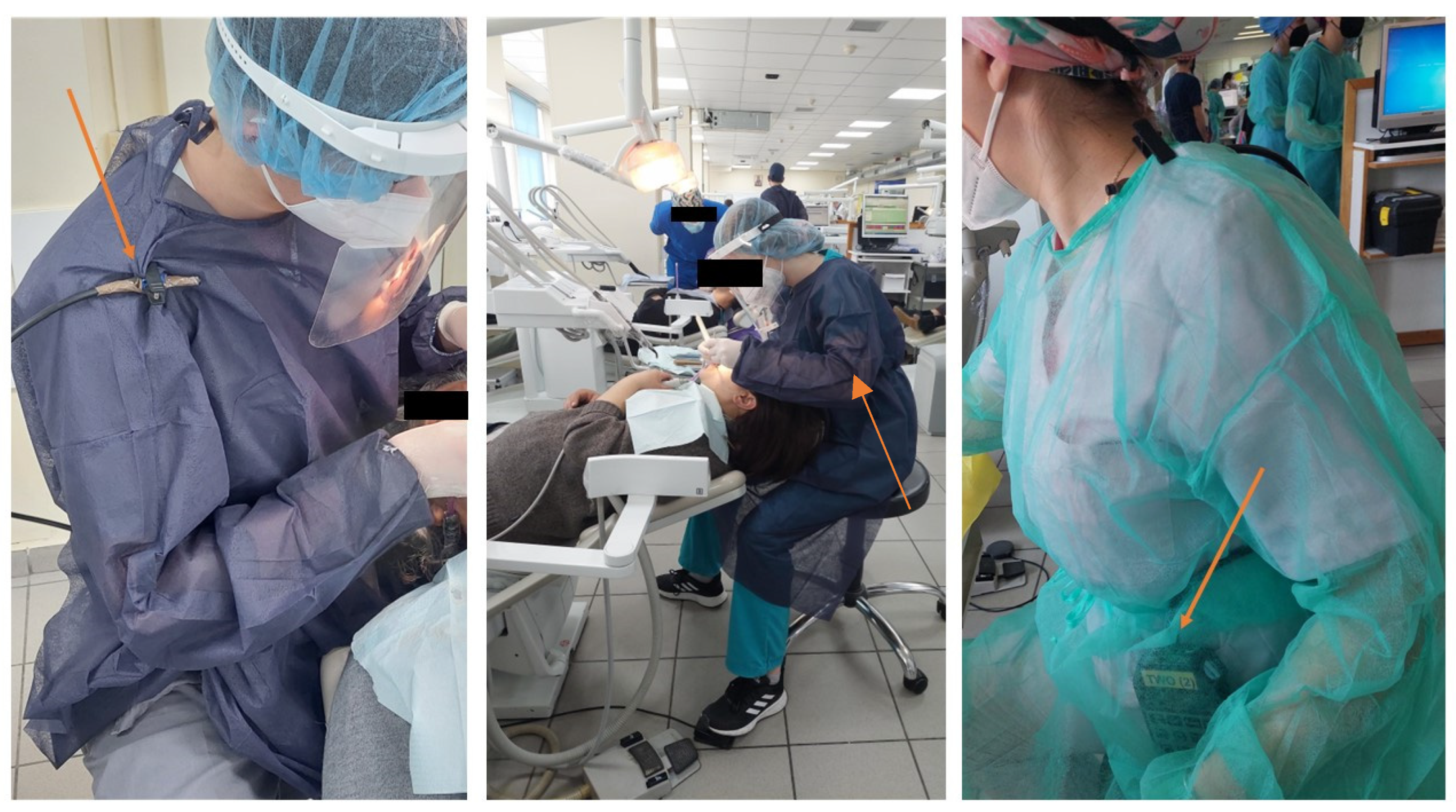
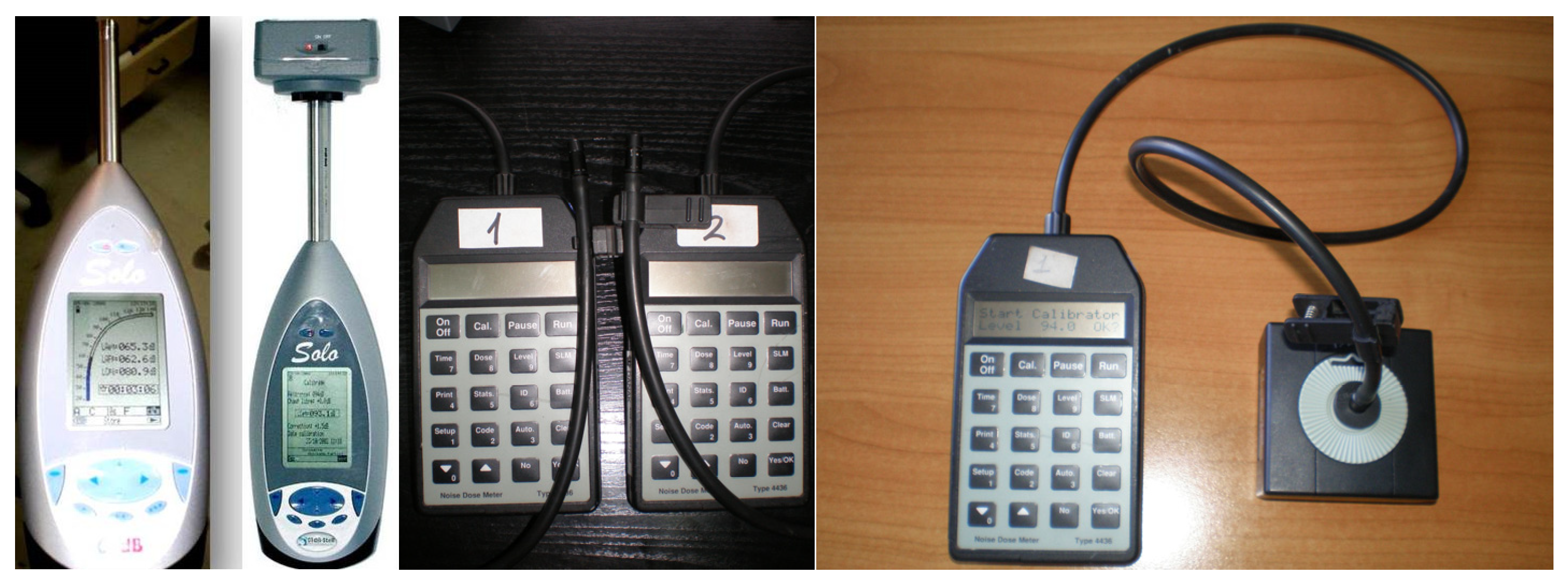
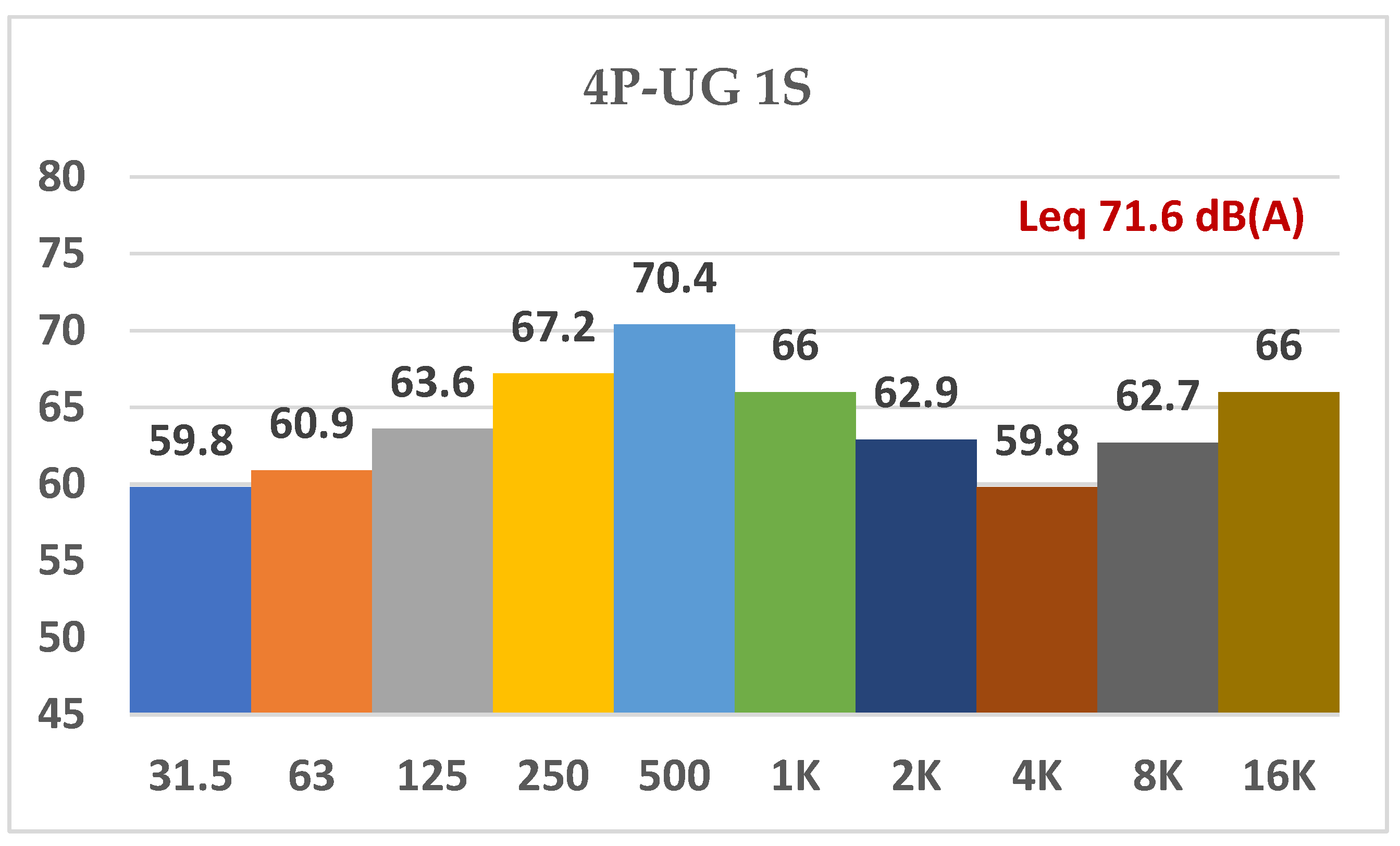
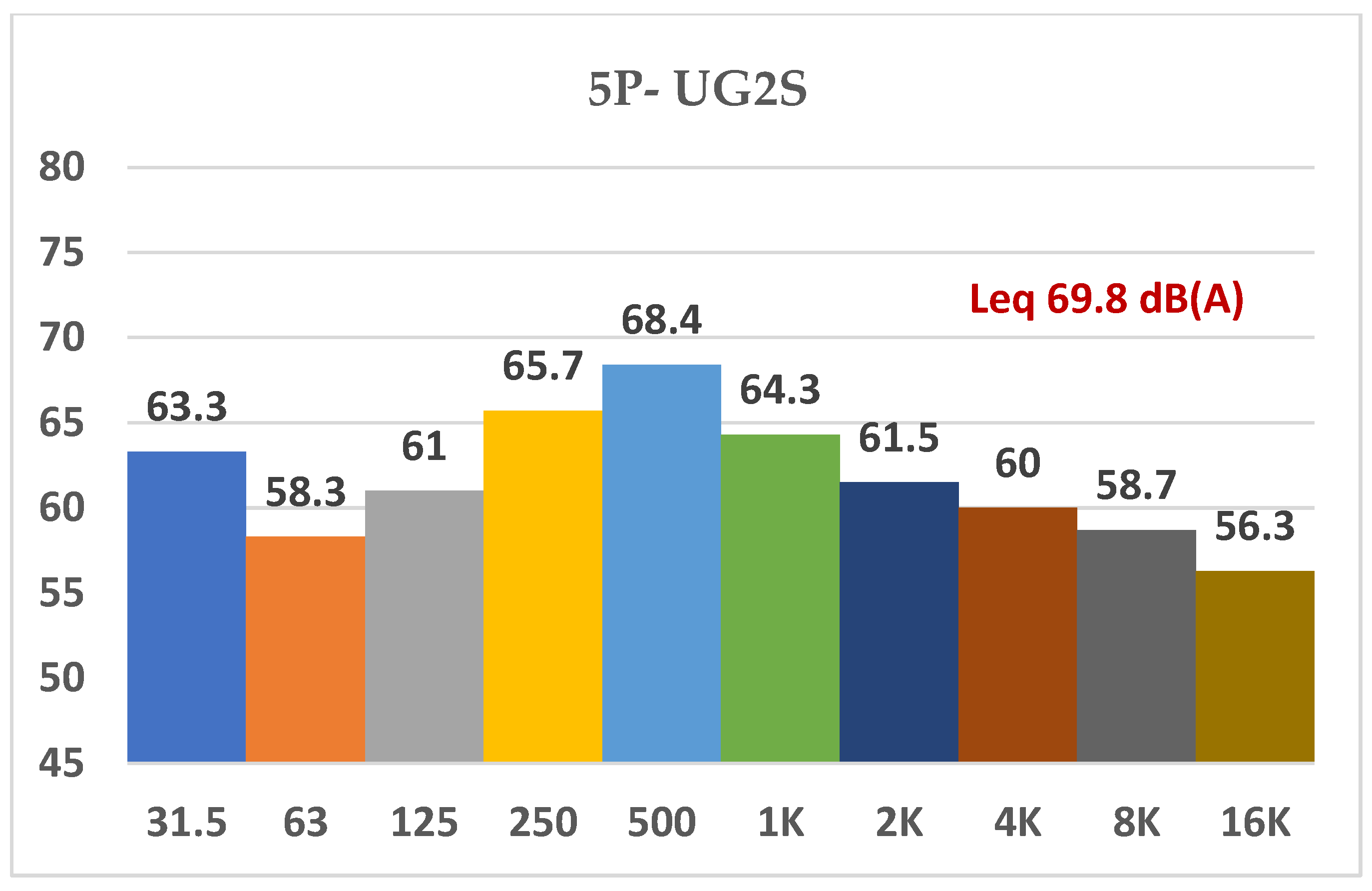
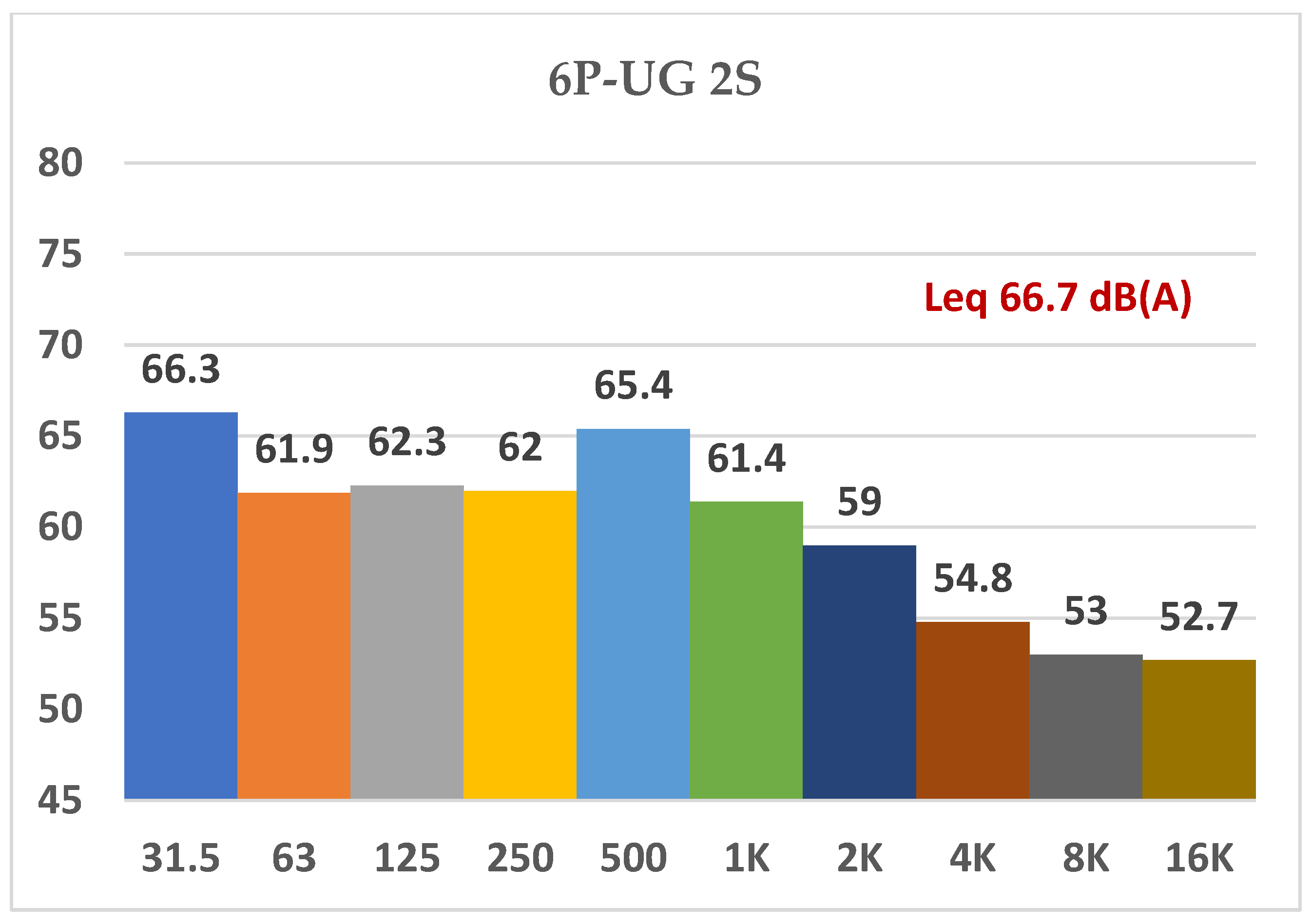
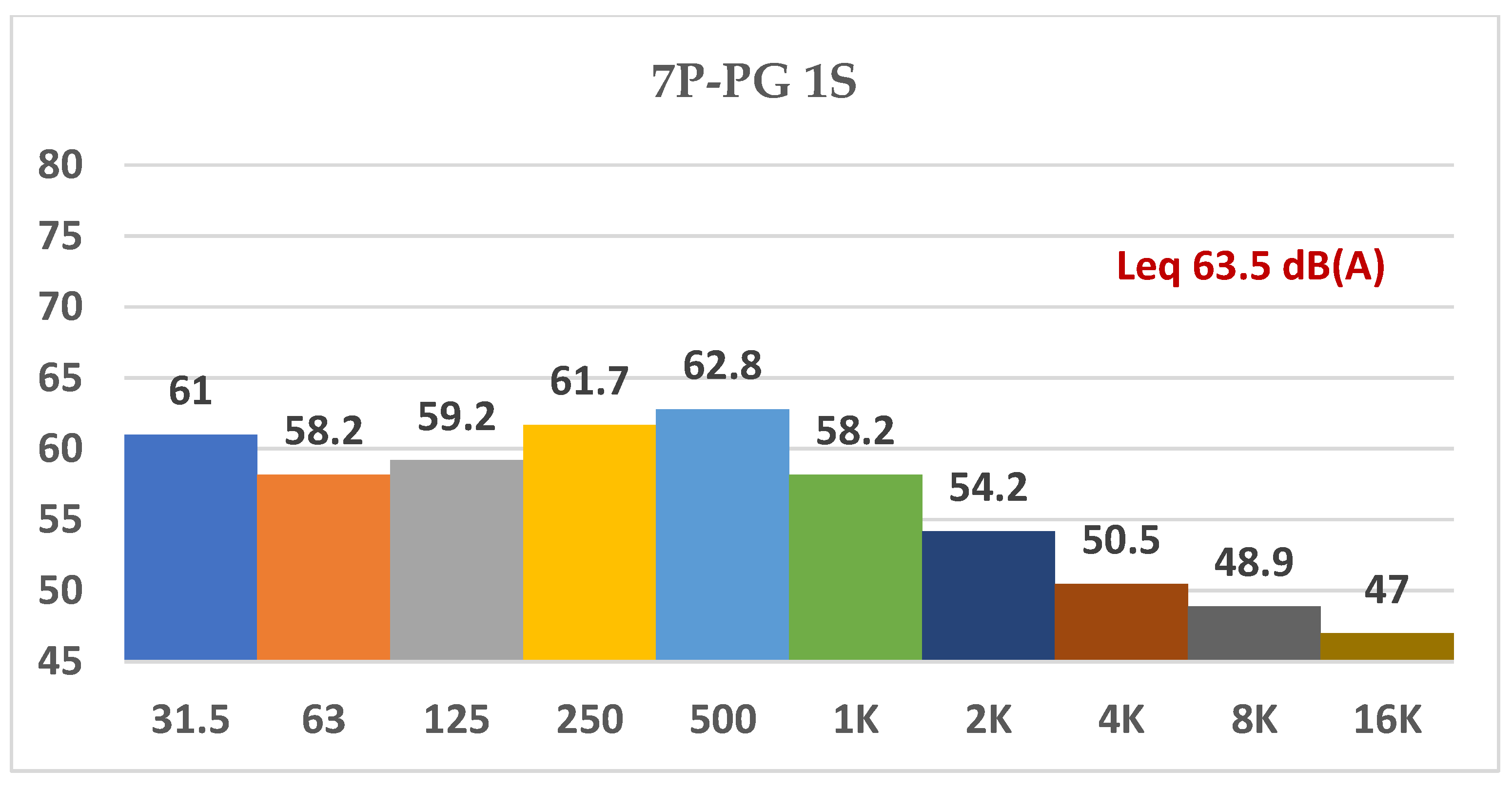

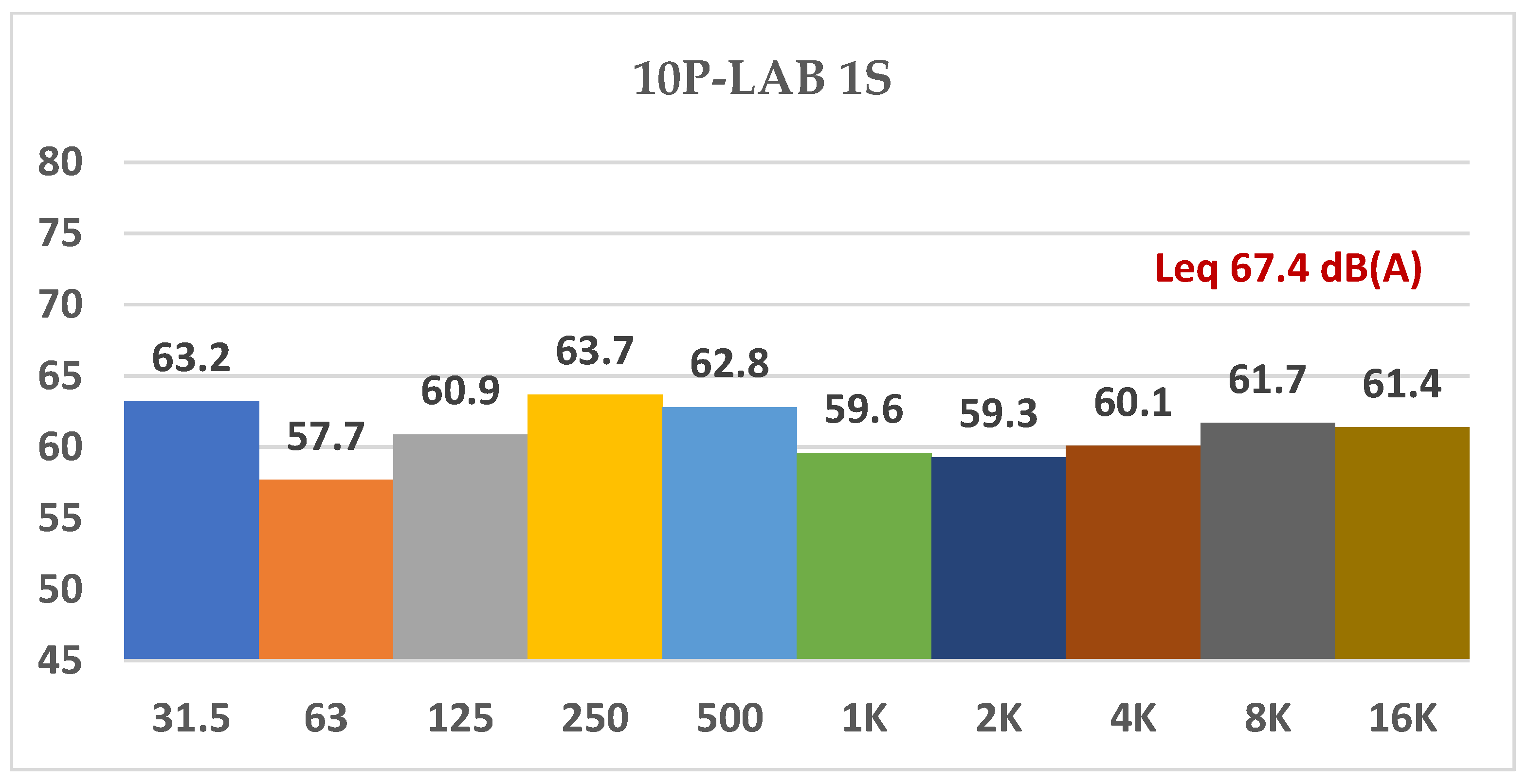
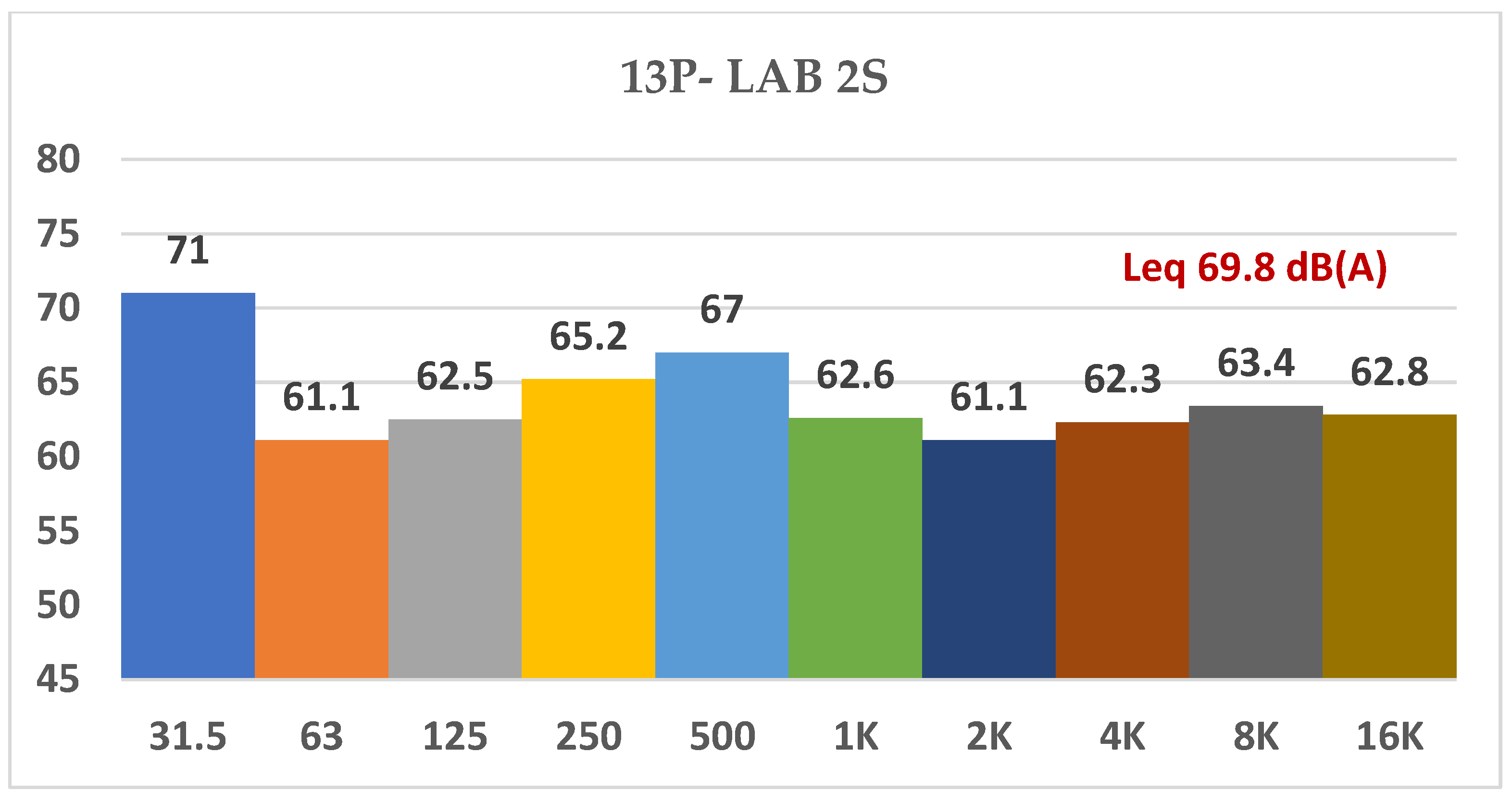
| Values | LEX, 8 h | Peak | Ppeak |
|---|---|---|---|
| Exposure limit values | 87 dB(A) | 140 dB© | 200 Pa |
| Upper exposure action values | 85 dB(A) | 137©(C) | 140 Pa |
| Lower exposure action values | 80 dB(A) | 135 dB(C) | 112 Pa |
| Measurements Settings | Personal Dosemeters (for Personal Exposure Measurement) | Static Measurements |
|---|---|---|
| UG1, 2nd floor (40 dental operatory units, 25 years old, 280 m2 × height 2.90 m) | Two users for 67 min Number of people present: 34 students, 12 personnel | Three static positions for 23 min each |
| UG2, 3rd floor (40 dental operatory units, 15 years old, 280 m2, height 2.90 m) | Two users for 73 min Number of people present: 33 students, 12 personnel | Three static positions for 18 min each |
| PG1, 2nd floor (12 dental operatory units, of 1 year old, 162 m2, height 2.90 m) | Two users for 58 min Number of people present: 10 dentists, 10 patients, and 6 personnel | Three static positions for 27 min each |
| PG2, 4th floor (12 dental operatory units, 1 year old, 162 m2, height 2.90 m) | Two users for 45 min Number of people present: 8 dentists, 8 patients, and 4 personnel | Three static positions for 18 min each |
| LAB1, basement (40 dental operatory units, 1 year old, 105 m2, height 2.90 m) | Two users for 38 min Number of people present: 36 students and 8 personnel | Three static positions for 18 min each |
| LAB2, basement (40 dental operatory units, 30 years old, 105 m2, height 2.90 m) | Two users for 39 min Number of people present: 40 students and 3 personnel | Three static positions for 31 min each |
| Position | Clinic/Laboratory | Method | LA | M.Peak dB(C) | Time (Min) | LeqdB(A) |
|---|---|---|---|---|---|---|
| 1P | UG1, hand instruments, airotor/micromotor | Personal measurement | 102.5 | 119.4 | 67 | 78.5 |
| 2P | UG2 hand instruments, airotor/micromotor | Personal measurement | 101.1 | 128.5 | 73 | 74.5 |
| 3P | UG2 ultrasonic handpiece, hand instruments | Personal measurement | 108.6 | 119.6 | 58 | 80.8 |
| 4P | UG1S all sounds | Static measurement | 82.1 | 103.0 | 23 | 71.6 |
| 5P | UG2S all sounds | Static measurement | 81.2 | 100.3 | 20 | 69.8 |
| 6P | UG2S all sounds | Static measurement | 77.5 | 97.8 | 18 | 66.7 |
| 7P | PG1 all sounds | Static measurement | 77.0 | 108.8 | 27 | 63.5 |
| 8P | PG2 all sounds | Static measurement | 80.2 | 107.5 | 15 | 71.7 |
| 9P | PG2 ultrasonic handpiece and hand instruments | Personal measurement | 109.6 | 133.9 | 45 | 78.0 |
| 10P | LAB1 airotor, acrylic cutting | Static measurement | 74.7 | 96.7 | 16 | 67.4 |
| 11P | LAB1 airotor/micromotor | Personal dosemeters | 101.6 | 128.9 | 38 | 76.5 |
| 12P | LAB2 airotor/micromotor use | Personal measurement | 105.1 | 133.2 | 39 | 78.9 |
| 13P | LAB2 airotor/micromotor | Static measurement | 89.0 | 115.9 | 31 | 69.8 |
Disclaimer/Publisher’s Note: The statements, opinions and data contained in all publications are solely those of the individual author(s) and contributor(s) and not of MDPI and/or the editor(s). MDPI and/or the editor(s) disclaim responsibility for any injury to people or property resulting from any ideas, methods, instructions or products referred to in the content. |
© 2023 by the authors. Licensee MDPI, Basel, Switzerland. This article is an open access article distributed under the terms and conditions of the Creative Commons Attribution (CC BY) license (https://creativecommons.org/licenses/by/4.0/).
Share and Cite
Antoniadou, M.; Tziovara, P.; Konstantopoulou, S. Evaluation of Noise Levels in a University Dental Clinic. Appl. Sci. 2023, 13, 10869. https://doi.org/10.3390/app131910869
Antoniadou M, Tziovara P, Konstantopoulou S. Evaluation of Noise Levels in a University Dental Clinic. Applied Sciences. 2023; 13(19):10869. https://doi.org/10.3390/app131910869
Chicago/Turabian StyleAntoniadou, Maria, Panagiota Tziovara, and Sophia Konstantopoulou. 2023. "Evaluation of Noise Levels in a University Dental Clinic" Applied Sciences 13, no. 19: 10869. https://doi.org/10.3390/app131910869
APA StyleAntoniadou, M., Tziovara, P., & Konstantopoulou, S. (2023). Evaluation of Noise Levels in a University Dental Clinic. Applied Sciences, 13(19), 10869. https://doi.org/10.3390/app131910869







